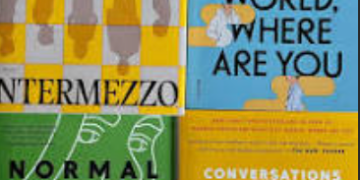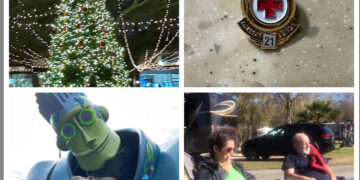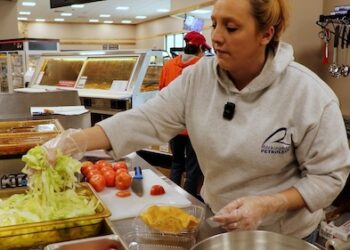Not too long ago, I had the opportunity to accompany my 1st grade grandson and his class from Fulks Run Elementary, on a field trip to the Brethren & Mennonite Heritage Center in Harrisonburg.
I love museums, but had never heard of this one. Probably because I am not from here originally.
Right in Harrisonburg, high on a hill above Harrisonburg High School off Garbers Church Road, is a group of historic buildings, most moved from other locations to create this wonderful village.
Upon arrival, the school groups were divided up with a parent or teacher leader, and were assigned a color coded docent. Our docent was Dee Stutzman, a very lovely and informative guide.
It was a brisk and sunny day, perfect for an outdoor field trip. The docents led the groups on their guided tours through all the buildings on the property. It gave the children a feel for life hundreds of years ago, where most of them were surprised to learn that many of the daily chores back then, fell to the families’ children! You were never too young to help at something. Everybody had a job, whether it was pumping water, feeding the animals, or hanging the wash on the line. Quite a different world from that of today’s children.
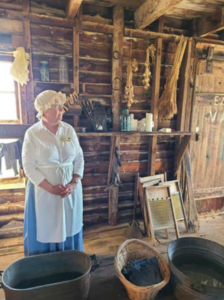
Each building on the property has been moved to the present site, and meticulously restored, complete with artifacts of the day. The buildings range in age from the 1700s through the early 1900s. The children visited the shoemaker, the blacksmith, the wood shop, wash house, school house, the main house. At each stop, there was a hands on demonstration, so children could get the feel of what it actually like was to live back in those days.
The shoemaker shop is from the 1790s, having belonged to Jacob Heatwole from PA. All that was left of it was the foundation and the cold cellar. It was formerly located near Walmart on Rte 42.
The 2nd oldest building is the 1829 log house. Nearby, the brooder house told of the history of the Wampler family, was filled with antique feeders, heat lamps, and a pair of taxidermied turkeys.
The blacksmith shop was run by a real blacksmith, Larry Martin, who demonstrated how to make a wrought iron hook. A huge, antique bellows donated by the Brethren, was operated by one of the assistants, keeping the flames burning, and the fire the right temperature. When the demo was finished, the blacksmith presented the leader/teacher of each group with a handmade hook.
would say the wash house was very enlightening for the children – including my grandson, who rolled up his sleeves with his classmates, to learn how to wash a sock- using an old washboard and lye soap. After that lesson – they each went outside and learned how to properly hang a wrung out sock on the line, using a wooden peg. A far cry from today’s washer and dryer!
One question asked at almost every site, was “do you know whose job this was?” 9 times out of ten, the answer was “the children”. By the end of the tour, the kids caught on that life was very different back then, when kids had a lot more responsibility from a very young age.
In the main house bedroom, kids learned the origin of the phrase “sleep tight, don’t let the bed bugs bite”, after viewing a rope bed.
They learned about heating bricks to put under the blankets to keep warm on cold nights, and about the chamber pot under the bed. Guess whose job it was to empty that chamber pot every morning? That’s right – the children!
The old fashioned one room schoolhouse, which was moved here from Mathias, WV, was a popular stop. The bell rang, the school teacher held a short lesson, similar to what would have been held back then, in a room full of children of all ages.
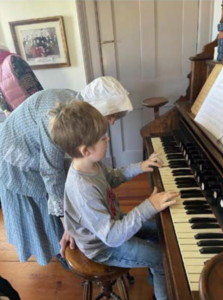
In the kitchen of the main house, the classes had a chance to pass around and shake a jar to make butter and taste homemade ice cream and cookies. 168 years old, the house was moved up the hill, from its original site, where the high school now stands. It took 6 bulldozers, and amazingly the house arrived almost unscathed – just a few cracks in the walls and a window.
In the parlor, all were entertained in what was a typical family gathering – singing, reading, playing with simple wooden toys. Each child got to sit at and try an antique Theiry reed pump organ in the parlor.
Also found on the 22-acre site, are the charred remains of a barn from Mt. Solon, which had been set on fire by Union soldiers during the Civil War.
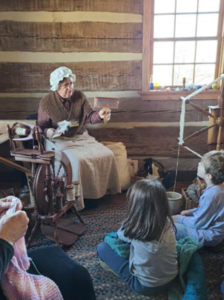
In all the buildings, there were volunteers dressed in period clothing, demonstrating different things, such as quilting, spinning, weaving. In one room, the children got to come up one by one, and guess what the uses of different shaped baskets were. And, again – guess who made use of those baskets during daily chores? That’s right, the children!! They ended the tour by playing some games typical of the era, like figuring out a wooden Jacob’s ladder.
School trips are held at the Center in the spring and the fall. Over 6 weeks in the spring, about 800 children in field trips visit the center. In the fall, the estimate is about 1,000 children.
As stated in the brochure, the Heritage Center is “the only religious interpretive center in Virginia”, with a “distinctive and unique perspective on the Civil War”. It is “the history of the Shenandoah Valley, reflected through the lives of settlers who shaped the land with a culture of peace.”
Recently, I was able to talk to Pastor Paul Roth, who is very involved with the Paul Kline House in Broadway and the Heritage Center in Harrisonburg. He is a wealth of information and there will be a follow up to this story in our March issue. Pastor Roth discusses future plans and upcoming programs at the Heritage Center. It truly is a hidden gem in plain view, high on a hill in Harrisonburg.
For more information – http://www.BrethrenMennoniteHeritage.org
540.438.1275
Open 10am-5pm, Wed-Sat
Mondays and Tuesdays by appointment
























